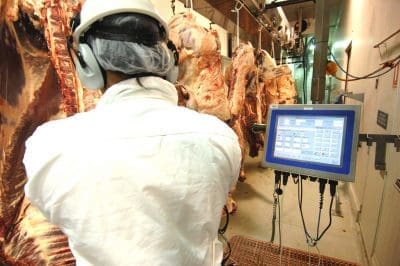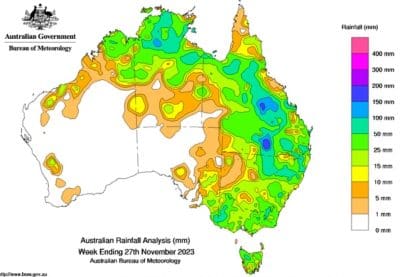WIDESPREAD rain over the past three weeks has had a considerable direct and indirect impact on slaughter cattle pricing and availability this week.
With only three working weeks left for the 2023 season for many processors, some Queensland operators have lifted their public grids by 20-30c/kg since Friday, while many southern processors are up 10-15c, as gaps in kill rosters suddenly appear.
 Part of that is evidently due to suppliers who had booked cattle earlier for direct consignment on a grid slot only (no price attached), now withdrawing stock. That’s left processors in something of a scramble, as the supply situation has quickly gone from ‘heavily booked for weeks ahead’ to ‘we could use some numbers.’
Part of that is evidently due to suppliers who had booked cattle earlier for direct consignment on a grid slot only (no price attached), now withdrawing stock. That’s left processors in something of a scramble, as the supply situation has quickly gone from ‘heavily booked for weeks ahead’ to ‘we could use some numbers.’
Adding to the momentum has been the significant lift in saleyards pricing over the past fortnight, motivating processors to lift their direct consignment grids to keep pace. Cows offered in northern saleyards have been making anywhere from 400-440c/kg dressed equivalent since the rain started a fortnight ago. Physical sales held earlier this week saw cows sell for as much as 470c/kg equivalent (Warwick), and 447c (Gunnedah) this morning, while Wagga sale yesterday saw cows make 220c/kg liveweight, on leg.
‘Wet weather money’ has also played a part in this week’s advancing grid offers in some areas, with processors incentivising suppliers to get into sodden paddocks to put a few decks together, due to cancellations or delays.
 In Central Queensland, where some regions have received 100-200mm over the past week, several processors are now anticipating some ‘dark days’ ahead (i.e. day-to-day plant closures) because of lack of access to cattle already booked. At one point the rail line from Winton to Rockhampton was closed last week, with one cattle consignment having to be offloaded to complete the balance of its journey by road.
In Central Queensland, where some regions have received 100-200mm over the past week, several processors are now anticipating some ‘dark days’ ahead (i.e. day-to-day plant closures) because of lack of access to cattle already booked. At one point the rail line from Winton to Rockhampton was closed last week, with one cattle consignment having to be offloaded to complete the balance of its journey by road.
With only a few exceptions, large parts of eastern and northern Australia’s heartland cattle country have now had a good, early seasonal start. More discussion on recent rain below.
Here’s some representative over-the-hooks grids Beef Central has seen this morning:
- Southern Qld: Four-tooth grass ox 460-470c/kg; heavy cows 390-400c – up 20-30c/kg on last week. Some grids have only been adjusted this morning. It’s at least 15 months since price rises on over-the hooks cattle have risen by this much in a week. Some smaller southern Qld processors are offering as much as 420c/kg flat on cows this week, evidently with special manufacturing beef orders to fill. Worth noting, however, some southern Qld plants have withdrawn grids for the year, confident that they now have remaining kill spaces covered
- Central Qld: Either the same, or 10c behind the southern QLD prices quoted above
- Southern NSW: four-tooth grass ox 420c/kg, heavy cows 370c – both up 15c last week
- Eastern SA: four-tooth ox 420c/kg, heavy cows 370c – both up 10c this week. Both southern NSW and eastern SA rates were coming off what was seen as a lower base.
Some processors have pointed out that the offers outlined above are effectively only for the last week or two of the current season, starting 11 December for many.
One multi-site processor pointed out that numbers required at the new price were not huge, given how close the annual plant closure period now is. Much of it was about securing the no-quote, space-only cattle bookings, now that the dynamics have changed, and keeping pace with a rapidly rising saleyards market.
Due to a large 50-70c/kg pricing disparity between Queensland rates and southern regions over the past few weeks, there’s been plenty of evidence recently of northern processors pulling relatively cheap cows and steers out of southern areas for slaughter. The 20c/kg freight bill to get southern cattle to plant for a period looked like a small price to pay. However recent southern saleyards price increases, and rising southern grid offers, are likely to take much of that incentive away for the time being.
What does the cattle price shift mean for early 2024?
So what is the significance in latest grid price movements for the opening stages of the 2024 season?
Too early to tell, is the common response. Closing prices in one season are no guarantee that they will open at the same level the following year. But given the rain that has now fallen across large parts of northern, eastern and southern Australia, it’s hard to see any downside from mid-January re-start – even if the current rain cycle was to stop this week.
Any early start to the traditional northern wet like this normally spells a long grass-growing season, provided weather does not peter-out half-way through. Feedback from processor cattle buyers across the country this morning is that the country is responding incredibly to the rain that’s already fallen.
Big shift in sentiment
The tightening in slaughter cattle supply comes just two weeks after the industry registered its largest weekly kill for the year. Week 47, ended 17 November saw NLRS report a seven-day national kill of 132,529 head, the biggest number seen in 2023, and the largest since 2020. Significantly, female slaughter ratio last week also climbed to its highest number this year, at 48.08pc (47pc is seen as the tipping point between herd contraction and expansion). Last week was the first with an FSR above 47pc since the week ending 6 October.
The size of last week’s kill can partly be explained by an extra Saturday shift scheduled at some of Australia’s largest beef plants, including JBS Dinmore, in response to earlier drought turnoff pressure and bushfire impact on pasture resources.
BOM weather
The BOM map published here shows rainfall for the week ended yesterday. The full November rain map is not yet available (due Friday), but it will show an even darker green/blue trend for the accumulated rain that’s fallen since November 1.

There was a level of disquiet emerging among some processors as the rate of national kill started to ramp-up since the end of September, due to drought and bushfire pressures.
Some felt the industry was prematurely ‘eating into’ next year’s slaughter cattle turnoff, at considerably lighter weights.
Many of those cattle are now likely to be held over until 2024, to be processed at weights 40-60kg heavier than they are today.
